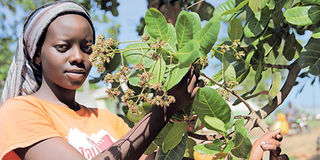Cashew nuts sector is growing but new pests dim prospects

Grace Mapenzi checks on cashew nuts grown on her parents' farm in Kilifi County. Efforts to revive the crop's industry have started to pay off with increased production in all of its catchment counties. PHOTO | FILE | NATION MEDIA GROUP
What you need to know:
- Initially, the area under cultivation had declined from 28,758 to 21,284 hectares between 2015 and 2016, bringing down production from 18,907 tonnes in 2015 to 11,404 tonnes in 2016.
- Kilifi, the most productive county, recorded an increase from 4,344 tonnes in 2018 to 4,779 in 2019. Kwale had a production of 3,448 tonnes in 2018 compared to 3,759 in 2019.
- Raymond Kahindi, the head of the Nuts and Oil Crop Directorate, said there are deliberate efforts to boost production, including the supply of quality seedlings to farmers.
- Intense lobbying by processors led to the banning of exports of nuts in shell in 2009 in a move meant to help them bunch enough nuts and create new jobs.
Efforts to revive the cashew nuts industry, which started three years ago, have started to pay off with increased production in all of the crop’s catchment counties.
In 2019, the total estimated area under cashew nuts was 22,686 hectares, a marginal improvement from 22,655 in 2018, according to the Nuts and Oil Crops Directorate of the Agriculture and Food Authority.
Initially, the area under cultivation had declined from 28,758 to 21,284 hectares between 2015 and 2016, bringing down production from 18,907 tonnes in 2015 to 11,404 tonnes in 2016.
Last year, harvests stood at 12,800 metric tonnes. In its good years in the 80s, production rose to as high as 36,000 metric tonnes per year.
Kilifi, the most productive county, recorded an increase from 4,344 tonnes in 2018 to 4,779 in 2019. Kwale had a production of 3,448 tonnes in 2018 compared to 3,759 in 2019.
Similarly, Lamu’s production rose from 3,422 tonnes in 2018 to 3,745 last years, AFA says. In 2018, the produce fetched Sh518 million compared to Sh583 million last year.
The government supplied 280,000 new varieties of seedlings to farmers last year. They mature in three years if proper crop husbandry is followed, meaning that the yield will improve significantly by next year.
“There has been good rainfall since last year and a significant proportion of the seedlings, unlike in the past, have survived. Some have reached about five feet and are likely to start yielding fruits next year,” said David Njuguna, the chairman of Lake Kenyatta Cooperative Society in Lamu, which buys cashew nuts from its 6,000 members.
He added that the region received 120,000 trees in last year.
The new varieties can produce up to 75 kilos per tree per year, depending on the crop husbandry employed.
Raymond Kahindi, the head of the Nuts and Oil Crop Directorate, said there are deliberate efforts to boost production, including the supply of quality seedlings to farmers.
Farm-gate prices for raw cashew nuts remained largely stable last year, but recorded an upsurge towards the end of the season due to greater competition and scarcity of the produce.
LOW INVESTMENT IN COTTAGE INDUSTRIES
Prices averaged Sh75 in Kwale and Kilifi and Sh80 in Lamu during the harvest season, AFA says. The market price for kernel, on the other hand, averaged Sh1,000 per kilo at cottage factory level across the production belt.
“It is, however, important to note that the farm-gate prices are in most instances lower than those reported due to the high number of intermediaries who tend to share profits which would otherwise be available to farmers,” Kahindi said
This year, farmers are still holding on to their produce due to a slowdown in market activities in the wake of the Covid-19 pandemic that has affected international markets.
However, there is a challenge in quality due to invasion by new pests last year, says Njuguna. The recovery rate, he said, is at 34 per cent, fetching farmers low prices of Sh30 per kilo.
There is also very low investment in cottage industries, leading to low consumption of the crop at local levels.
For instance, even though Lamu is a major cashew catchment area, producing about 4,000 metric tonnes in 2019, it does not have any industry, denying residents job opportunities by exporting all the nuts to processors spread in Nairobi and Central.
Frank Omondi, the managing director of Ten Senses Africa, a new processor in the Coast region, said the crop’s poor fortunes can be traced from the collapse of the Kenya Cashew Nuts Factory in the late 90s, when cooperative movements formed by farmers collapsed.
This broke the organised marketing system, with brokers emerging as the central players, buying produce at low prices and selling it to exporters and processors
Intense lobbying by processors led to the banning of exports of nuts in shell in 2009 in a move meant to help them bunch enough nuts and create new jobs.
However, when the agriculture function was devolved after the 2013 election, a multisectoral approach to revitalise the sector was not transitioned to county governments, leading to poor budgetary allocation.
“For this initiative to move on with the reforms, it required a champion. And after devolution, it lost that champion, when the sector needed support to produce more nuts and employ proper crop husbandry,” said Charles Muigai, NutPAK chief executive officer.
Organising the farmers into producer groups has been left to processors, which exposes them to the danger of losing their negotiating power.





